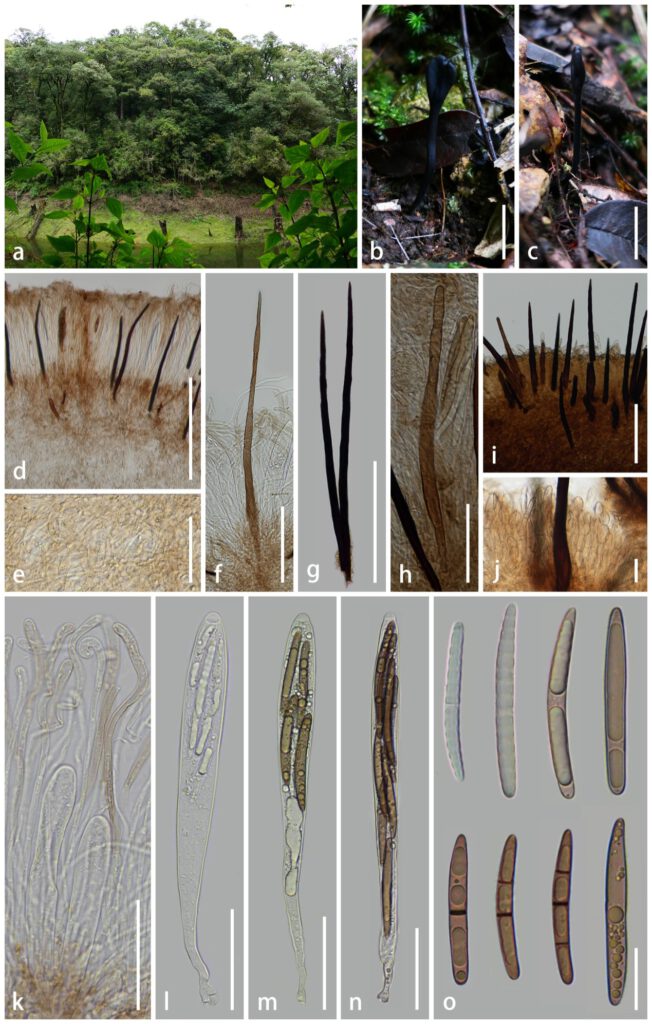Trichoglossum ailaoensis H.L. Su & Q. Zhao, sp. nov. Fig. 1
MycoBank number: MB; Index Fungorum number: IF; Facesoffungi number: FoF 12891;
Etymology: Referring to the type locality Ailao Mountains, Yunnan Province in China.
Diagnosis: Characterized by short asci and ascospores, the mature ascospores are dark brown and 0 ‒3 septate, paraphyses are light brown at base and apex, hyaline in the middle.
Saprobic on soil. Sexual morph: Ascocarp superficial, scattered, 3‒5 cm high, black, an inflated head that tapers into a thin stipe, typically spathulate, longly stipitate. Fertile part 0.2‒0.4 × 0.5 ‒1.0 cm, flattened, usually vertically grooved, irregularly twisted, black, surface dry, densely setose. Stipe up to 4.5 cm tall and about 1‒3 mm in diam, cylindrical, surface densely setose, rough, black. Ascomatal core lightly brownish, 2.5 – 4.5 µm (x̄ = 3.3 µm, n = 72) in middle, thick-walled cells of textura intricate. Stipitipellis 60–90µm (x̄ = 70 µm, n = 14) thick, light brownish, 11.0–23.0 × 6.0–11.0 µm (x̄ = 15.5 × 8.0 µm, n = 34), cells of textura porrecta, with setae at the outmost flanks. Hymenial setae 130–340 × 5.5–12.0µm (x̄ = 193 × 7.8 µm, n = 28), needle-like, mostly sharp-pointed, fewly blunt-pointed, unbranched, mostly aseptate, fewly multi-septate, thick-walled, smooth, brown to black, numerous. Stipe setae 130–275 × 6.5–16.0µm (x̄ = 186 × 10.5 µm, n = 25), the shape and color are similar to hymenial setae. Paraphyses 2.0 – 3.5 µm (x̄ = 172 × 2.9 µm, n = 54) in middle, longer than asci, filiform, swollen and hooked at the apices, swollen part 4.0–7.5 µm (x̄ = 5.1 µm, n = 54) in diam, unbranched, septate, thin-walled, slightly smooth, light brown at base and apex, colourless in the middle, numerous. Asci 200 – 250 × 14.5 – 25.0 µm (x̄ = 218 × 19.4 µm, n = 36), narrowly cylindrical to broadly clavate, rounded apex, narrowed below, inoperculate, pleurorhynchous, wall apically thickened and laterally thin, hyaline, 8-spored, unitunicate, amyloid. Ascospores (109/2/2) (46.5–)49.5–67.0(–69.5) × (4.0–)4.8–6.9(–7.6) µm, (x̄ = 59.7 × 5.8µm, Q = 7.7–14.2, Q = 10.4 ± 1.07), clavate with rounded ends, slightly curved to straight, slightly smooth, thin-walled, 0‒3 septate, with 1–4 large oil guttules, initially hyaline, eventually becoming dark brown. Asexual morph: Unknown.
Material examined: China, Yunnan, Ailao Mountains, alt. 2434 m, on soil, 1 September 2021, H.L. Su, SHL145 (HKAS 124482, holotype); ibid., alt. 2478 m, on soil, 29 August 2021, H.L. Su, SHL64 (HKAS 124481, paratype).
Notes: The phylogenetic analyses show that Trichoglossum ailaoensis is sister to the clade of T. walteri and T. farlowii. They all have clavate, black apothecia, densely covered with needle-like setae, similar paraphyses. However, Trichoglossum walteri has larger asci and ascospores, and the mature ascospores are 7-septate, while the mature ascospores of T. ailaoensis are 3-septate. Trichoglossum farlowii has mature light brown ascospores with 5 septa, while T. ailaoensis has mature dark brown ascospores with 3 septa.

Fig.1 Trichoglossum *** (HKAS 124482, holotype) a Habitat. b–c Typical mature apothecia. d Vertical section of apothecia. e Section of ascomatal core. f–h Hymenial setae. i Transversal section of stipe. j Stipitipellis. k Paraphyses and immature asci. l–n Asci. o Ascospores. Scale bars: b–c = 1cm, d = 200 µm, e = 50 µm, f–i = 100 µm, j = 10 µm, k–n = 50 µm, o = 20 µm.
